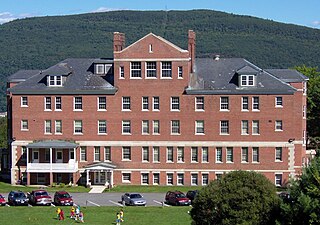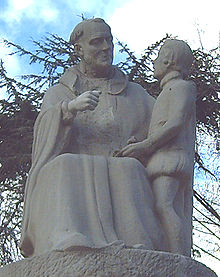
Deaf culture is the set of social beliefs, behaviors, art, literary traditions, history, values, and shared institutions of communities that are influenced by deafness and which use sign languages as the main means of communication. When used as a cultural label especially within the culture, the word deaf is often written with a capital D and referred to as "big D Deaf" in speech and sign. When used as a label for the audiological condition, it is written with a lower case d. Carl G. Croneberg coined the term "Deaf Culture" and he was the first to discuss analogies between Deaf and hearing cultures in his appendices C/D of the 1965 Dictionary of American Sign Language.
Signing Exact English is a system of manual communication that strives to be an exact representation of English language vocabulary and grammar. It is one of a number of such systems in use in English-speaking countries. It is related to Seeing Essential English (SEE-I), a manual sign system created in 1945, based on the morphemes of English words. SEE-II models much of its sign vocabulary from American Sign Language (ASL), but modifies the handshapes used in ASL in order to use the handshape of the first letter of the corresponding English word.
Audism as described by deaf activists is a form of discrimination directed against deaf people, which may include those diagnosed as deaf from birth, or otherwise. Tom L. Humphries coined the term in his doctoral dissertation in 1975, but it did not start to catch on until Harlan Lane used it in his writing. Humphries originally applied audism to individual attitudes and practices; whereas Lane broadened the term to include oppression of deaf people.
Manually coded languages (MCLs) are a family of gestural communication methods which include gestural spelling as well as constructed languages which directly interpolate the grammar and syntax of oral languages in a gestural-visual form—that is, signed versions of oral languages. Unlike the sign languages that have evolved naturally in deaf communities, these manual codes are the conscious invention of deaf and hearing educators, and as such lack the distinct spatial structures present in native deaf sign languages. MCLs mostly follow the grammar of the oral language—or, more precisely, of the written form of the oral language that they interpolate. They have been mainly used in deaf education in an effort to "represent English on the hands" and by sign language interpreters in K-12 schools, although they have had some influence on deaf sign languages where their implementation was widespread.
Italian Sign Language or LIS is the visual language used by deaf people in Italy. Deep analysis of it began in the 1980s, along the lines of William Stokoe's research on American Sign Language in the 1960s. Until the beginning of the 21st century, most studies of Italian Sign Language dealt with its phonology and vocabulary. According to the European Union for the Deaf, the majority of the 60,000–90,000 Deaf people in Italy use LIS.

The Atlanta Speech School is a language and literacy school located in Atlanta, Georgia, established in 1938. The school provides educational and clinical programs. The Atlanta Speech School's Rollins Center provides professional development for teachers and educators in partner schools and preschools. The Rollins Center focuses on the eradication of illiteracy. The Rollins Center has an online presence called Cox Campus, which is an online learning environment with coursework targeted for the education of children age 0–8.
In the United States, deaf culture was born in Connecticut in 1817 at the American School for the Deaf, when a deaf teacher from France, Laurent Clerc, was recruited by Thomas Gallaudet to help found the new institution. Under the guidance and instruction of Clerc in language and ways of living, deaf American students began to evolve their own strategies for communication and for living, which became the kernel for the development of American Deaf culture.

The Austine School for the Deaf, now closed, in Brattleboro, Vermont, was an independent, coeducational day and residential school for deaf and hard-of-hearing children age four to eighteen from New England and New York.

Deaf education is the education of students with any degree of hearing loss or deafness. This may involve, but does not always, individually-planned, systematically-monitored teaching methods, adaptive materials, accessible settings, and other interventions designed to help students achieve a higher level of self-sufficiency and success in the school and community than they would achieve with a typical classroom education. There are different language modalities used in educational setting where students get varied communication methods. A number of countries focus on training teachers to teach deaf students with a variety of approaches and have organizations to aid deaf students.
Prelingual deafness refers to deafness that occurs before learning speech or language. Speech and language typically begin to develop very early with infants saying their first words by age one. Therefore, prelingual deafness is considered to occur before the age of one, where a baby is either born deaf or loses hearing before the age of one. This hearing loss may occur for a variety of reasons and impacts cognitive, social, and language development.
The history of deaf education in the United States began in the early 1800s when the Cobbs School of Virginia, an oral school, was established by William Bolling and John Braidwood, and the Connecticut Asylum for the Deaf and Dumb, a manual school, was established by Thomas Hopkins Gallaudet and Laurent Clerc. When the Cobbs School closed in 1816, the manual method, which used American Sign Language, became commonplace in deaf schools for most of the remainder of the century. In the late 1800s, schools began to use the oral method, which only allowed the use of speech, as opposed to the manual method previously in place. Students caught using sign language in oral programs were often punished. The oral method was used for many years until sign language instruction gradually began to come back into deaf education.
Language acquisition is a natural process in which infants and children develop proficiency in the first language or languages that they are exposed to. The process of language acquisition is varied among deaf children. Deaf children born to deaf parents are typically exposed to a sign language at birth and their language acquisition follows a typical developmental timeline. However, at least 90% of deaf children are born to hearing parents who use a spoken language at home. Hearing loss prevents many deaf children from hearing spoken language to the degree necessary for language acquisition. For many deaf children, language acquisition is delayed until the time that they are exposed to a sign language or until they begin using amplification devices such as hearing aids or cochlear implants. Deaf children who experience delayed language acquisition, sometimes called language deprivation, are at risk for lower language and cognitive outcomes. However, profoundly deaf children who receive cochlear implants and auditory habilitation early in life often achieve expressive and receptive language skills within the norms of their hearing peers; age at implantation is strongly and positively correlated with speech recognition ability. Early access to language through signed language or technology have both been shown to prepare children who are deaf to achieve fluency in literacy skills.

The Deaf rights movement encompasses a series of social movements within the disability rights and cultural diversity movements that encourages deaf and hard of hearing to push society to adopt a position of equal respect for them. Acknowledging that those who were Deaf or hard of hearing had rights to obtain the same things as those hearing lead this movement. Establishing an educational system to teach those with Deafness was one of the first accomplishments of this movement. Sign language, as well as cochlear implants, has also had an extensive impact on the Deaf community. These have all been aspects that have paved the way for those with Deafness, which began with the Deaf Rights movement.
The deaf community in Australia is a diverse cultural and linguistic minority group. Deaf communities have many distinctive cultural characteristics, some of which are shared across many different countries. These characteristics include language, values and behaviours. The Australian deaf community relies primarily on Australian Sign Language, or Auslan. Those in the Australian deaf community experience some parts of life differently than those in the broader hearing world, such as access to education and health care.

Harriet Burbank Rogers was an American educator, a pioneer in the oral method of instruction of the deaf. She was the first director of Clarke School for the Deaf, the first U.S. institution to teach the deaf by articulation and lip reading rather than by signing. Her advocacy for oralist instruction children increased utilization of oral-only communication models in many American schools.
Language deprivation in deaf and hard-of-hearing children is a delay in language development that occurs when sufficient exposure to language, spoken or signed, is not provided in the first few years of a deaf or hard of hearing child's life, often called the critical or sensitive period. Early intervention, parental involvement, and other resources all work to prevent language deprivation. Children who experience limited access to language—spoken or signed—may not develop the necessary skills to successfully assimilate into the academic learning environment. There are various educational approaches for teaching deaf and hard of hearing individuals. Decisions about language instruction is dependent upon a number of factors including extent of hearing loss, availability of programs, and family dynamics.
Language exposure for children is the act of making language readily available and accessible during the critical period for language acquisition. Deaf and hard of hearing children, when compared to their hearing peers, tend to face more hardships when it comes to ensuring that they will receive accessible language during their formative years. Therefore, deaf and hard of hearing children are more likely to have language deprivation which causes cognitive delays. Early exposure to language enables the brain to fully develop cognitive and linguistic skills as well as language fluency and comprehension later in life. Hearing parents of deaf and hard of hearing children face unique barriers when it comes to providing language exposure for their children. Yet, there is a lot of research, advice, and services available to those parents of deaf and hard of hearing children who may not know how to start in providing language.
The Language Equality and Acquisition for Deaf Kids (LEAD-K) campaign is a grassroots organization. Its mission is to work towards kindergarten readiness for deaf and hard-of-hearing children by promoting access to both American Sign Language (ASL) and English. LEAD-K defines kindergarten readiness as perceptive and expressive proficiency in language by the age of five. Deaf and hard-of-hearing children are at high risk of being cut off from language, language deprivation, which can have far-reaching consequences in many areas of development. There are a variety of methods to expose Deaf and hard-of-hearing children to language, including hearing aids, cochlear implants, sign language, and speech and language interventions such as auditory/verbal therapy and Listening and Spoken Language therapy. The LEAD-K initiative was established in response to perceived high rates of delayed language acquisition or language deprivation displayed among that demographic, leading to low proficiency in English skills later in life.
Deafness in Cuba encompasses many different topics. There are approximately 109,000 deaf people in Cuba. Some Cuban deaf people learn Cuban Sign Language, while others learn Spanish. Deaf culture is important to deaf people in Cuba.
Deafness in Portugal involves several elements such as the history, education, community, and medical treatment that must be understood to grasp the experiences of deaf and hard-of-hearing (DHH) individuals in this region. Currently there are 60,000 people in Portugal that are deaf sign language users. Among that number are 100 working sign language interpreters. Currently, the form of sign language used in Portugal is Portuguese Sign Language. In Portugal, the cities Lisbon and Porto have the largest deaf populations.






